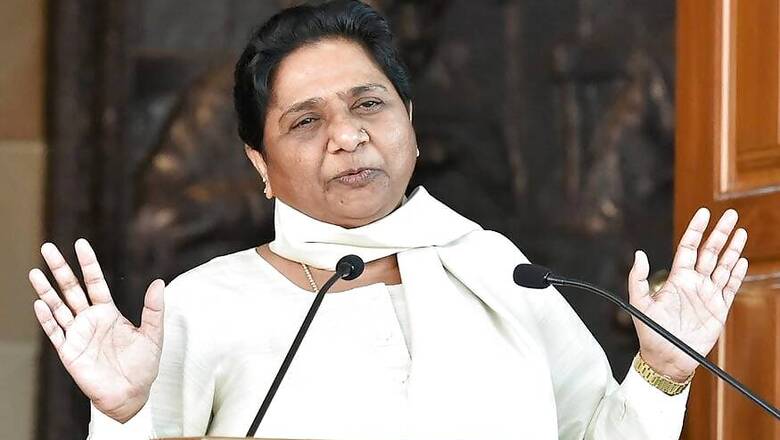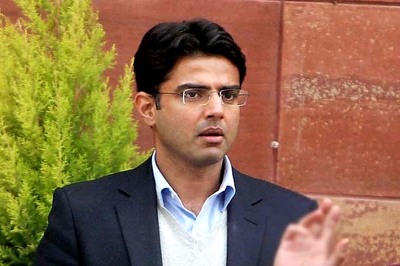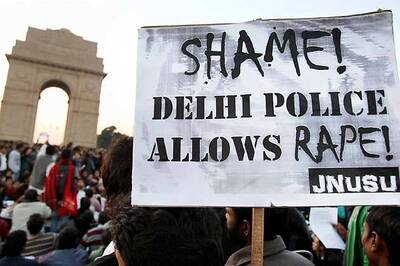
views
New Delhi: The Bahujan Samaj Party’s workers' conference in Meerut on Monday promises to be an acid test for party chief Mayawati exactly two months after she quit the Rajya Sabha.
In retrospect, 2017 hasn’t been a great year for BSP chief Mayawati. In fact, the year saw the Dalit czarina’s political fortune plumbing new depths.
In the crucial Uttar Pradesh Assembly polls, her party won only 19 of the 403 seats — a fraction of 206 it had bagged a decade ago. This decline was in the works. The ominous signs were repeatedly flashed — first in the 2009 Lok Sabha polls, followed by the 2012 Assembly elections and then again in 2014 parliamentary polls, but Mayawati was too confident about her abilities and saw the reverses as a blip in her party’s electoral fortunes.
The Decline
As her political stature grew, Mayawati started losing touch with her core Dalit constituency. Her meetings with the grassroots workers were few and far between, where the command flowed by the top often defied logic.
Political analysts say power and recognition brought streak of arrogance in her behaviour. Her birthdays were a brazen display of irrational extravagance.
While in power, she splurged on statues of Dalit heroes and built multi-crore ambitious Ambedkar theme parks dotted with hundreds of elephant statues — a naked display of caste politics, much to her rivals’ chagrin.
In April 2008, she became the first Uttar Pradesh Chief Minister to unveil her own statue on Gomati embankment in Lucknow.
Her megalomaniac ways brought her under constant public criticism where she was accused of squandering the hard-earned money of the people on building such mindless edifices.
There was a time when the BSP under its founder Kanshi Ram was staunchly opposed to nepotism. It never backed off in criticising dynasts, who promoted their own kith and kin at the cost of party workers.
Mayawati herself used to ridicule Mulayam Singh Yadav for promoting nepotism but charity never begun at home for Mayawati. In April, she appointed her brother Anand Kumar as the party's vice-president and her heir apparent, leaving even her staunchest supporters shell shocked.
Power brought money and later its vulgar public display. Mayawati, wearing much criticised crisp currency note garlands worth crores, was a common sight during party meets and rallies.
She flaunted her material possessions betraying shame and guilt. Her birthdays were occasions to collect cash from party workers. From Rs 1.12 crore in 1995, her income disproportionately ballooned to Rs 111.64 crore, as per her Rajya Sabha 2012 affidavit.
No wonder, SP Maurya, former senior BSP leader, accused her of not being a “Dalit's daughter, but of daulat’s (wealth)”. Her core supporters, many of whom were struggling to make ends meet, didn’t see her grand ways as sign of their own empowerment.
Besides, Mayawati's politics was based on victimhood, which has its own limitations. It does not have much to offer to her upwardly mobile and aspirational voters.
In absence of a new idea for Dalit emancipation, she started relying on her rhetoric of blaming the so-called “Manuwadi and Brahmanical” forces for all the Dalit ills. These tactics started sounding hollow and stopped resonating among her core voters.
Also, at a time when opinion and perception are built and demolished on social media platforms, she is far removed from the virtual space. She is neither on Twitter nor on Facebook. At the best of times, she lives in an ivory tower.
Instead of patronising new breed of leaders from her core Dalit base, she promoted Satish Chandra Mishra, a Brahmin, which sent a wrong message among her electorate. Mishra clearly lacked acceptability among Dalits.
Moreover, her perceived reluctance to go the whole hog against the BJP further dented her credentials. She was seen as going soft on the ruling party. Nowhere was it more palpable than her near silence over the issue of Swati Singh’s appointment as a minister in the Yogi Adityanath government in UP. Experts attributed this fragility to her innate fear of being hounded by the central agencies in the disproportionate assets and other cases at the BJP’s behest.
Besides, her politics became too much Jatav-centric, leaving other Dalit sub-castes like Paswan, Dhobi, Balmiki, Pasis, Khatik, Kori etc. in the lurch and consequently an easy prey for the BJP.
Her brand of politics has failed to add any other social groups to her Dalit stable. The on-off experiment of rainbow coalition, first with Brahmins and then with Muslims had a shelf life. The party’s Dalit-Brahmin collation was too precarious given the challenging job of keeping these two socio-economic extremes together. Muslims always had better scopes in the Samajwadi Party and the Congress.
In a nutshell, from a party born out of Dalit movement, Mayawati made it her personal fiefdom. Party leaders with mass base stopped seeing their future in the BSP. Dissidence and sacking became a routine affair.
Fast forward to 2017, and Mayawati’s political decimation was complete. Uttar Pradesh Assembly results put a big question mark over her political future. For the first time in many years, she was neither in power nor in the opposition.
Her divorce from political reality became all the more apparent when she started blaming electronic voting machine (EVM) tampering by the BJP for her UP poll rout. Political uncertainty was staring in her face.
However, Mayawati hasn’t lost the willingness to undo her mistakes and resurrect the party. Power is addictive and she understands it all too well. Another five years out of power could dishearten and demoralise the cadre and the BSP may even cease to exist.
Her Rajya Sabha resignation is seen by many as a genuine effort on her part towards her political reinvention.
The Challenges
But, donning a new avatar isn’t going to be easy. The party’s old guards like Swami Prasad Maurya and Naseemuddin Siddiqui are now her political rivals. Her current coterie is inexperienced, lacks political base and acumen.
The BJP has to some extent successfully dented her non-Jatav Dalit vote base. The nomination of a Dalit Ram Nath Kovind as the presidential candidate was seen as an attempt in a similar direction by the BJP.
Besides, the Dalit community stands divided amid the identity crisis of many sub-castes. With Mayawati embracing the Jatavs, the divide is starker than ever before.
Significantly, she is no longer the singular Dalit voice in the political sphere. A new breed of aggressive leadership is emerging among the community. The slogans, idea and ideals propagated by the likes of Dalit activist Jignesh Mevani and Chandrashekhar Azad of the Bhim Army find more takers and resonate among the younger generation.
The Blueprint
So, what can Mayawati do to script a comeback?
First and foremost, she needs to change her leadership style and the way she interacts with followers and her community at large. The vocabulary and language of her political discourse should be in sync with contemporary realities and must address their aspirations and concerns.
She must join social media; talk aspiration, dreams and not victimhood. No one likes a sad tale, definitely not Dalits who have faced discrimination for centuries. Tell Dalits what she could do for them and not crib over historical wrongs committed against the community.
The coterie surrounding her must be demolished and dependency on handful of leaders be reduced. Come out of the ivory tower. Become more accessible to leaders and workers.
The party and its leadership must also understand that the Dalit population is not homogenous. Economic and social forces have created incongruence among them. And, therefore, it must attempt to mend the multiple fault lines rather than exposing them for short-term gains.
Also, politics is a 24x7 job. It demands consistency. Going back to the electorate just before polls is no more an option. Voters need constant pampering.
And, a strong Dalit party needs support of each and every section of the caste grouping.
It is equally important that the party first consolidates the Bahujans (Dalits) before making attempts to lure other social groups.
The BSP’s inconsistent policies have created a vacuum in the Dalits' social movement. The void gave birth to groupings like the Bhim Army and Dalit activists like Jignesh Mevani. The BSP should endeavor to embrace and not confront these new social forces.
Importantly, Mayawati should lead from the front. She should learn to take responsibility for setbacks rather than finding a scapegoat like Naseemuddin Siddiqui.
Also, she should visit Dalit settlements more frequently and listen to their grievances. Addressing mega rallies have a limited appeal in this age of election micro-management.
Mayawati has the ability to integrate Dalits with mainstream Indian society. She can be the face of a new social construct, where inclusiveness would triumph over caste bias and vote bank politics.




















Comments
0 comment